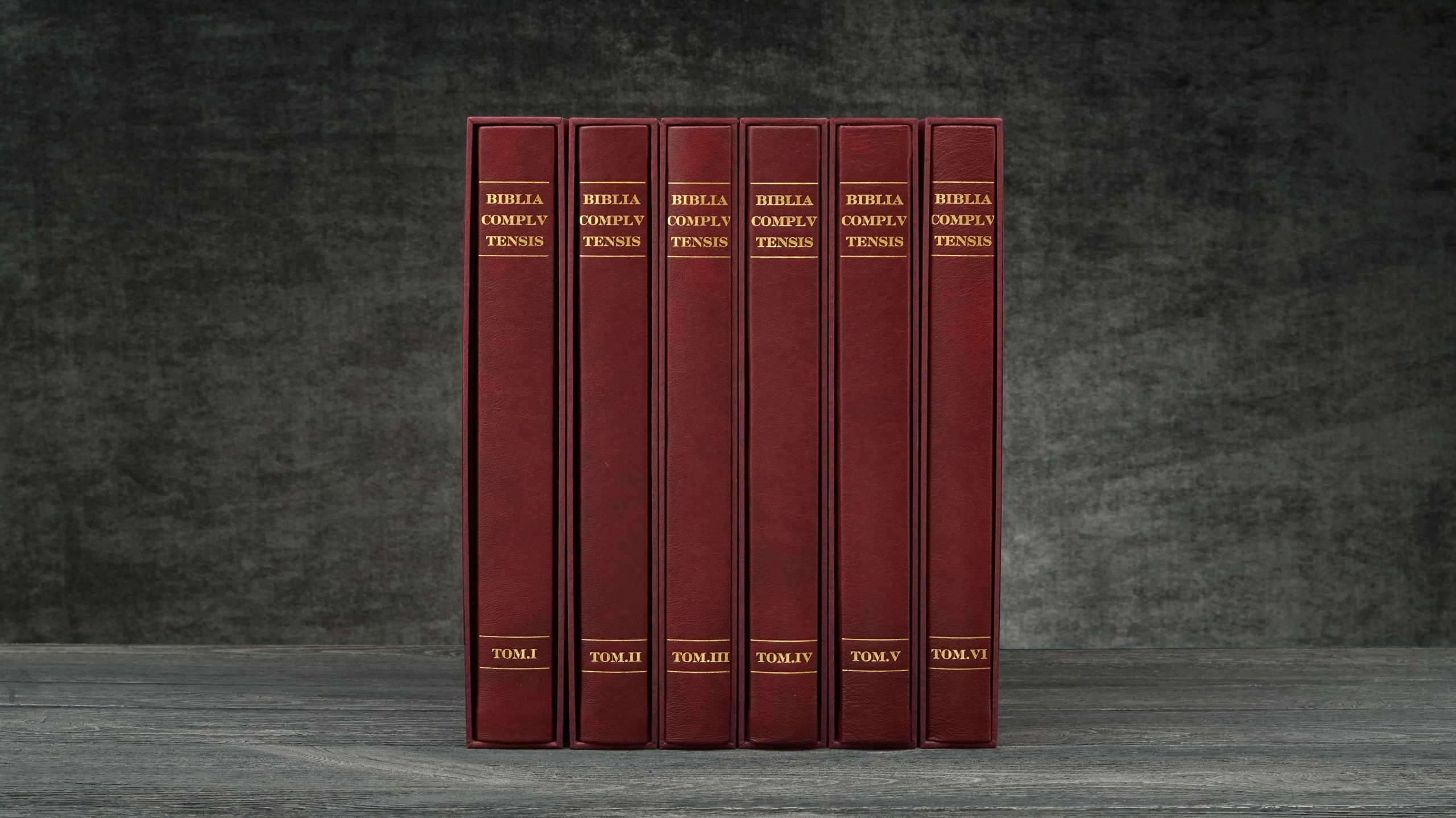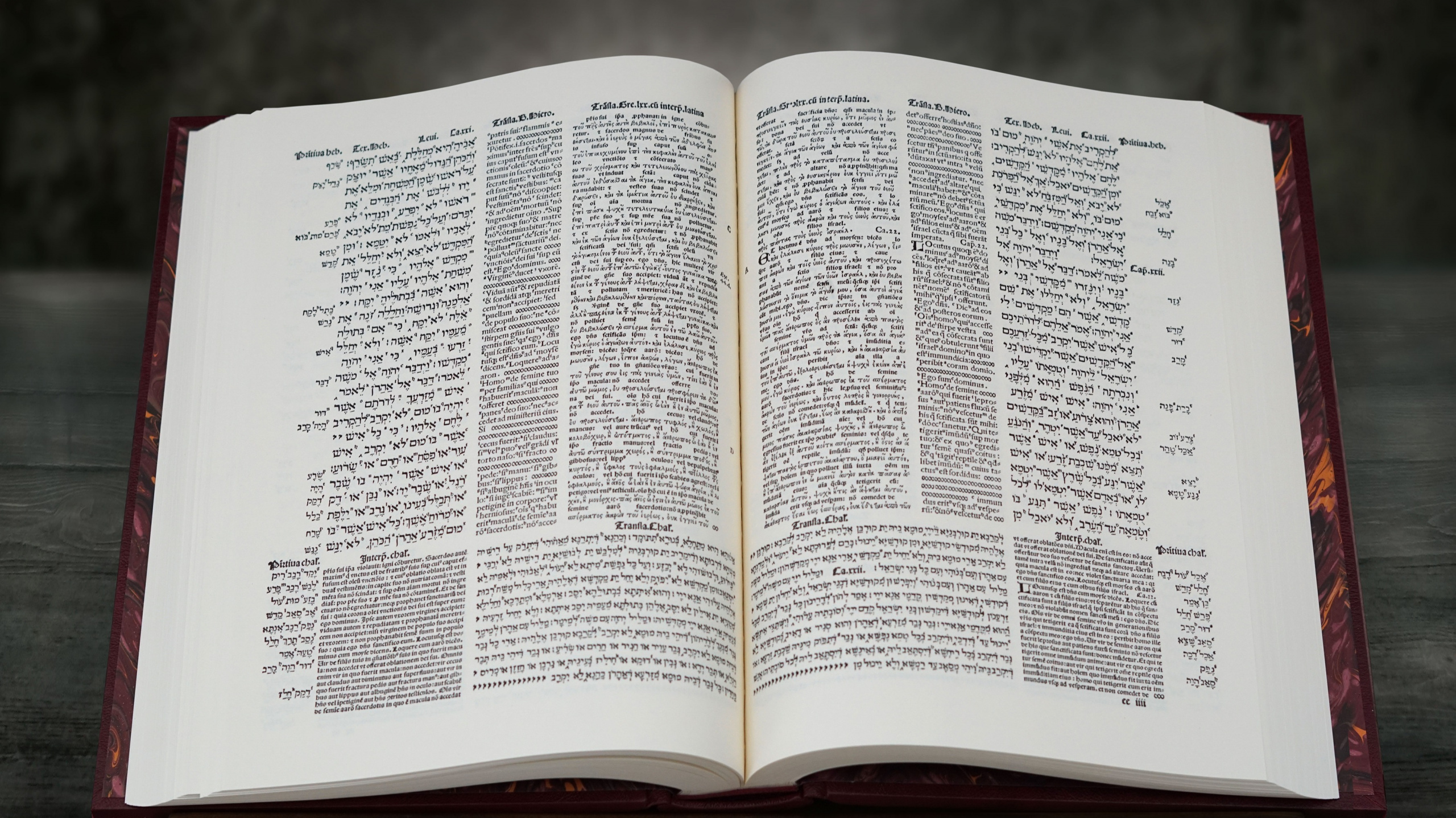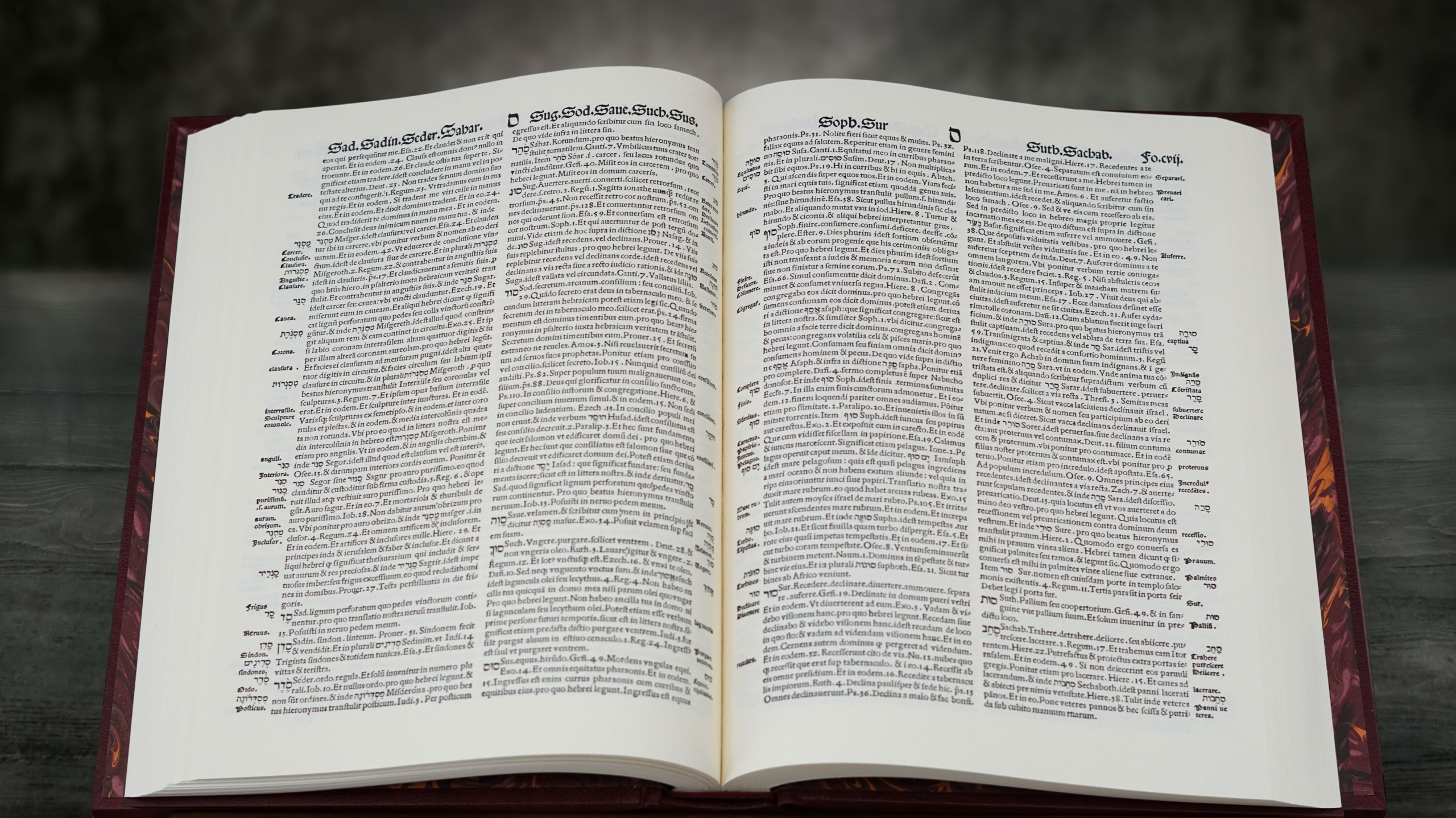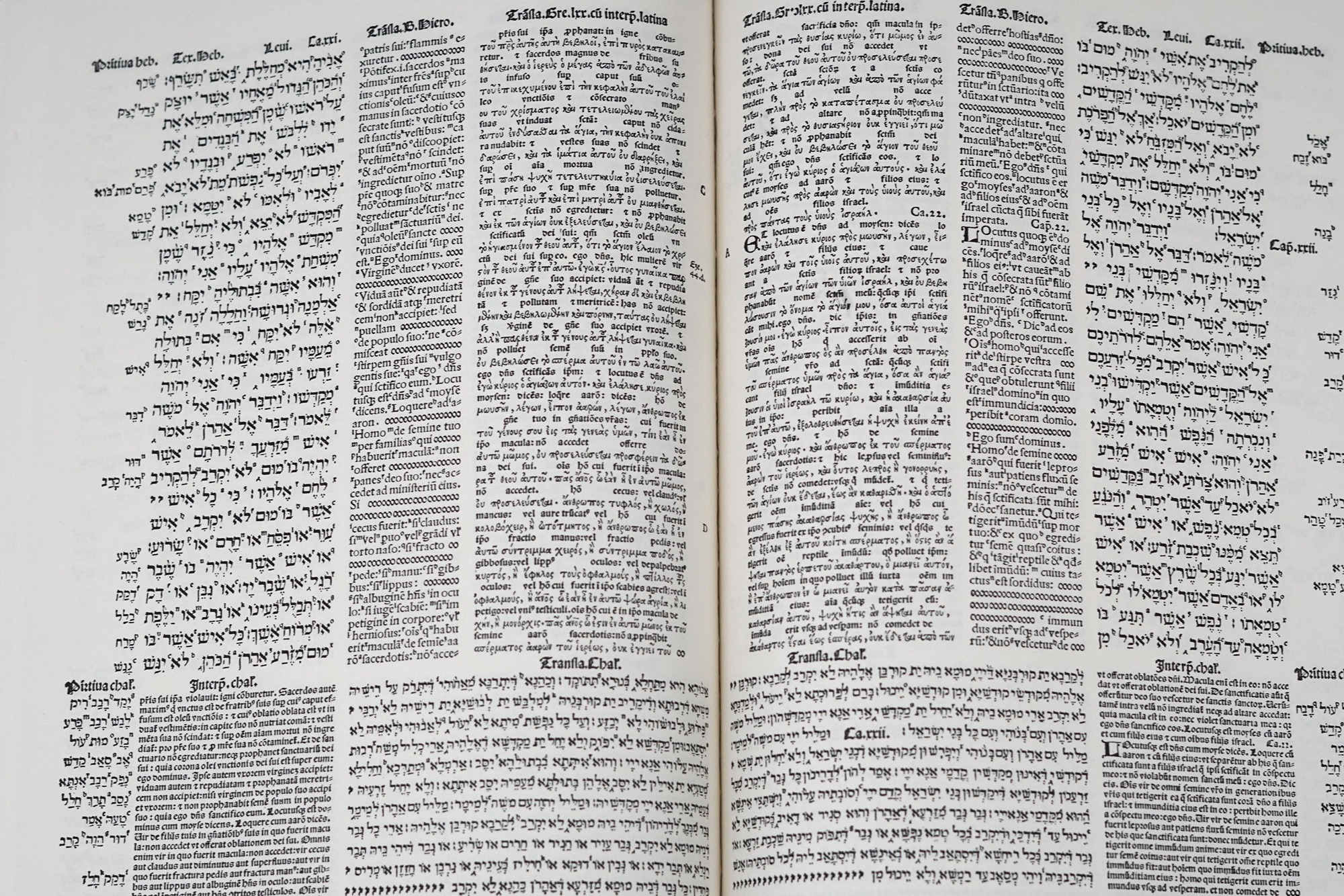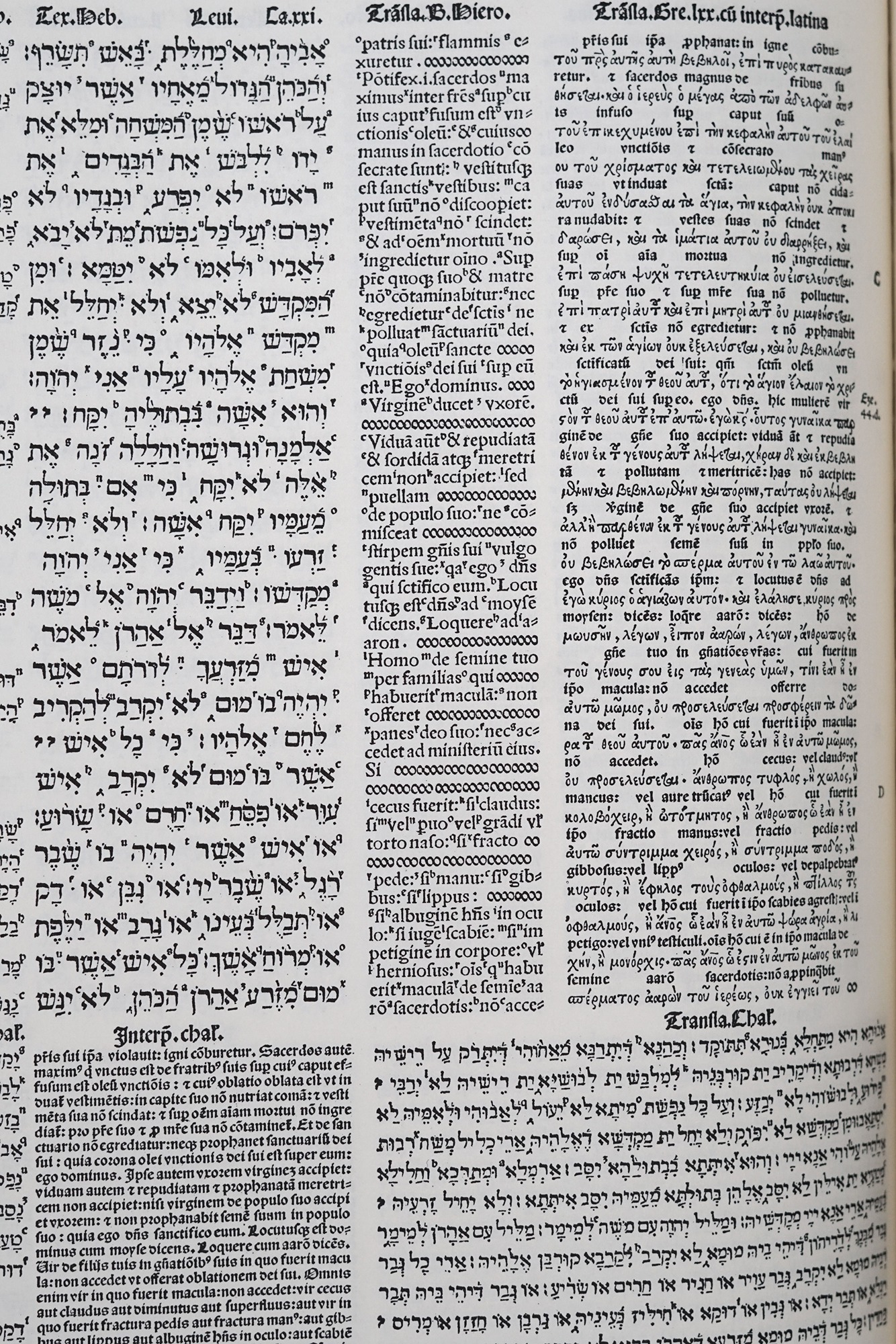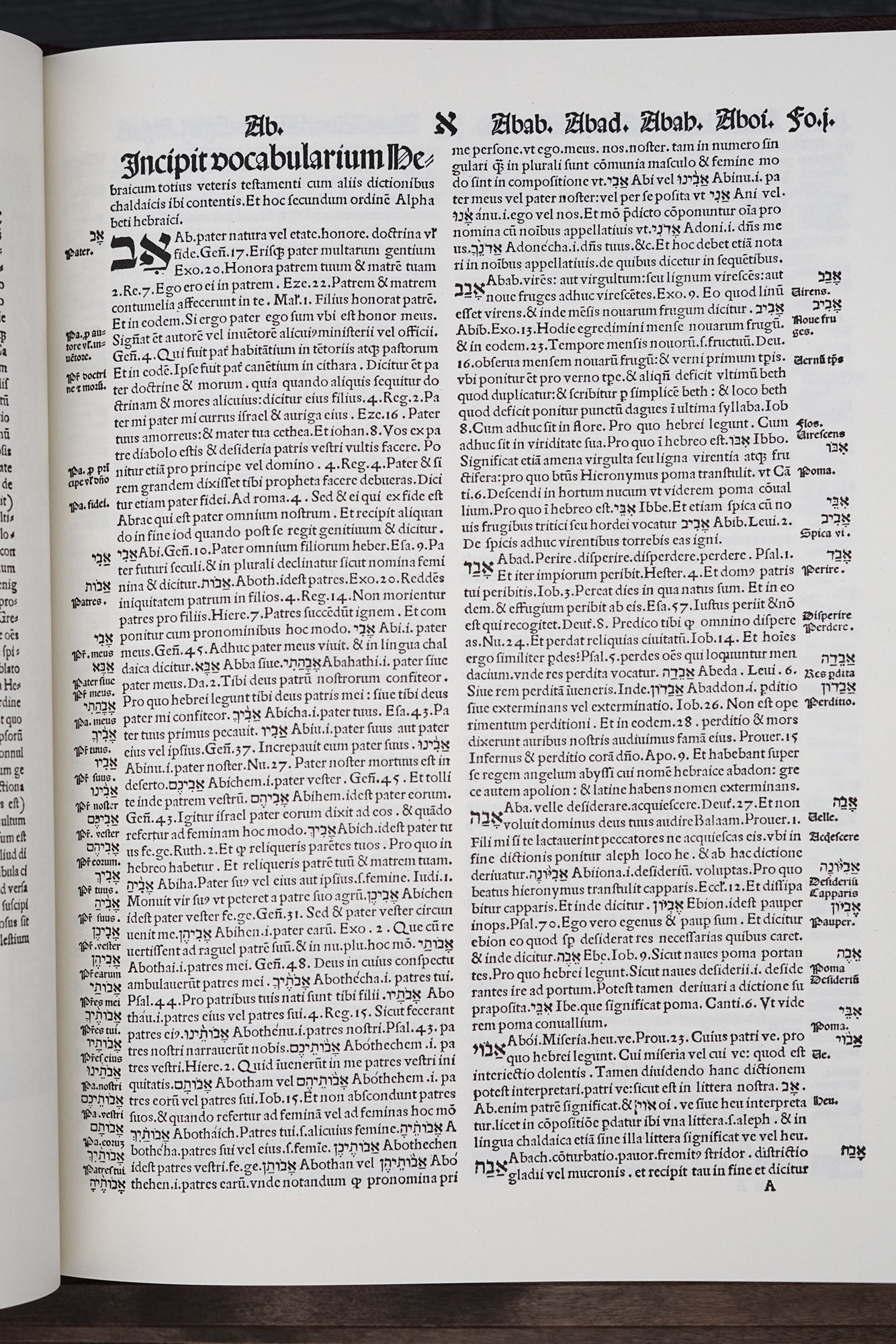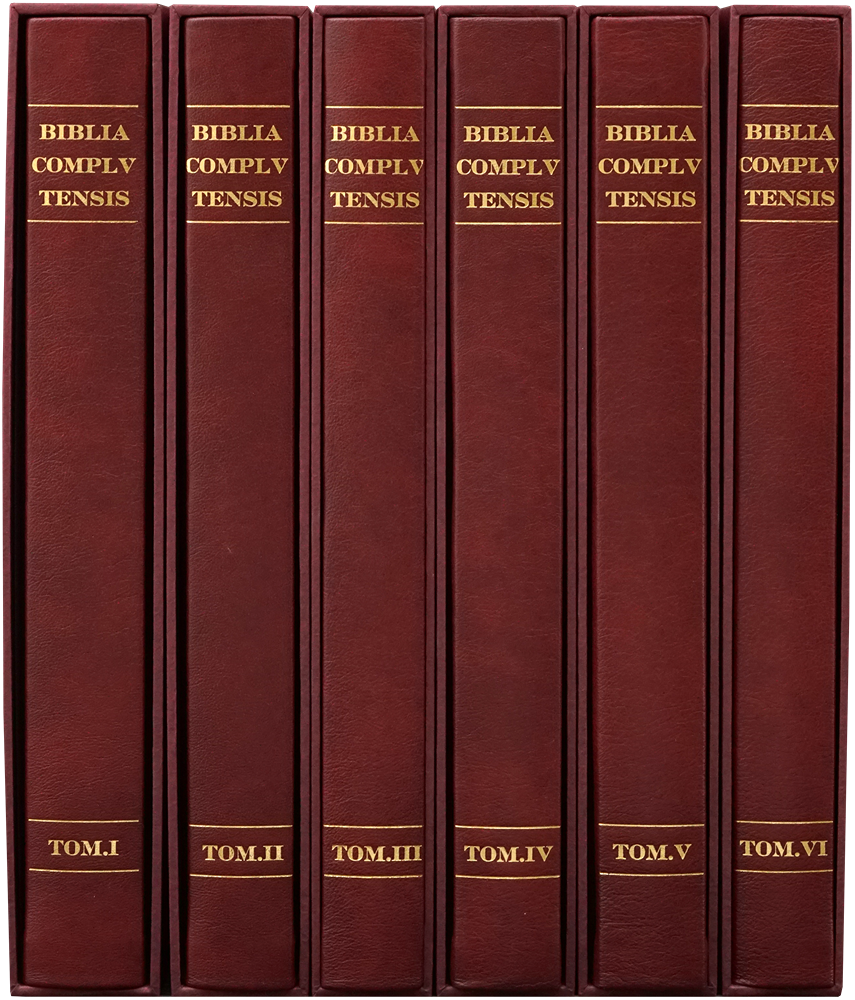1522 Complutensian Polyglot Bible
$2,995.00
NOTE: This 1522 Complutensian Polyglot 6 Volume facsimile set is no longer available, however… full color high resolution digital editions of many ancient Bibles of the 1300’s through the 1800’s are available for free online access at BIBLES-ONLINE.NET
Out of stock
Description
1522 Complutensian Polyglot Bible
Facsimile Reproduction
The six-volume Complutensian Polyglot Bible was printed between 1514 and 1522 but not bound and published until 1522. It is one of the three most important books ever printed in human history. Its 1514 printing of the New Testament in the original Greek predates the Erasmus 1516 edition by two years, making it the very first printing of a Greek New Testament, as well as the first printing of a complete Bible in the original languages. Most importantly, it gave the Protestant Reformers an accurate source text from which to translate and to make God’s Word available in many European languages throughout the 1500s.
NOTE: This 1522 Complutensian Polyglot 6 Volume facsimile set is no longer available, however… full color high resolution digital editions of many ancient Bibles of the 1300’s through the 1800’s are available for free online access at BIBLES-ONLINE.NET
Are you familiar with the very first printing of God’s Word in the original Biblical languages? It is one of the Top Three most important books ever printed, (the other two being the 1455 Gutenberg Bible, and the 1611 King James Bible), yet few have heard of it. I am speaking of the 1514-1522 Complutensian Polyglot Bible, which was issued as a six-volume set containing the complete Bible in the original Biblical languages of ancient Hebrew (& Aramaic) for the Old Testament and ancient Greek for the New Testament, as well as including the Latin because it was the standard academic reference language of that time.Our facsimile reproduction set of this milestone of printing history and Christian history is the only one published in modern times. We originally offered it to Seminaries and Christian University Libraries, and to the public on our website, in 2016 for $7,495. Years later, we began to liquidate the remaining sets at a lower price point. Because we have only ever printed fewer than 70 copies of this set, and only around a hundred of the complete originals (worth $350,000 each) are extant today… this is the only example I know of where our facsimile is actually rarer than the original!
It is also curious to consider: if you don’t own a copy of the Bible in the original ancient Greek and ancient Hebrew… you don’t really own a copy of the Bible as God delivered it unto Man… you just own a “translation” of the Bible into a modern European language like English or German … languages that did not exist in any recognizable form 1,000 years ago.
Our founder, Dr. Craig Lampe, once said:
“Of all the Biblical facsimile editions we have published over the past 25 years, I am more proud to have a copy of the Complutensian Polyglot in my home than anything else we have done.”
To further that thought, Dr. Lampe has only ever published two books (other than our Biblical facsimiles), and they are: “The Forbidden Book” – A History of The English Bible, and “How The Spanish Saved Christianity” – A History of The Complutensian Polyglot Bible. You will also receive a free copy of Dr. Lampe’s book on the history of the Complutensian Polyglot Bible.
More details on… the 1522 Complutensian Polyglot Bible:
The First Printing of God’s Word in the Original Biblical Languages
God’s Word is the ancient Hebrew Old Testament Era scriptures and the ancient Greek New Testament Era scriptures. For about a thousand years (circa 400 AD to 1,400 AD), the scriptures were primarily kept in Latin, which was originally a very accurate Latin translation, but it became corrupted over the centuries by the Church of Rome. The Protestant Reformation was all about replacing that corrupted Latin with accurate translations of God’s Word into languages people could read, such as English, German, Spanish, etc. The goal was to set people free from the heresies, deceptions, and financial extortion scams (selling admission to heaven, selling forgiveness ) which were being perpetrated on them by those seeking to prevent the public from reading God’s Word on their own, to see what it really said.
But before Gods’ Word could be translated into the commonly spoken European languages like English (by Tyndale) and German (by Luther), and Spanish (by De Renia)… an accurate source text of the original Biblical languages was needed. In one of the greatest ironies of history, it was actually a Spanish Cardinal of the Church of Rome that spearheaded the effort to collect and preserve God’s Word accurately in the original tongues. Cardinal Francisco Jimenez (or Ximenes) may have been associated with the Roman Catholic Church, but he was certainly acting like a Protestant as he spent the equivalent of $12.5 million in gold to acquire and typeset the very first printed Bible in the original languages of Hebrew (and Aramaic) and Greek, and as it was the standard reference of its day, he also included the Latin… all in side-by-side columns.
The result was the six-volume Complutensian Polyglot Bible, which was printed between 1514 and 1522, but not bound and published until 1522. It is one of the three most important books ever printed in human history. Its 1514 printing of the New Testament in the original Greek predates the Erasmus 1516 edition by two years, making it the very first printing of a Greek New Testament, as well as the first printing of a complete Bible in the original languages. Most importantly, it gave the Protestant Reformers an accurate source text from which to translate and to make God’s Word available in many European languages throughout the 1500’s.
The typesetting, with its several different blocks of languages grouped across the pages, makes the Complutensian Polyglot Bible one of the most beautiful printed books ever produced. In spite of how extremely important this book is, fewer than 200 people today personally own a copy of it (either original or facsimile), as so very few originals and so very few facsimile copies have ever been produced. It is indeed an elite club to be among those very few people in the world who possess a copy of the first printing of the Bible in the original languages.
NOTE: This 1522 Complutensian Polyglot 6 Volume facsimile set is no longer available, however… full color high resolution digital editions of many ancient Bibles of the 1300’s through the 1800’s are available for free online access at BIBLES-ONLINE.NET
A Brief History of the Complutensian Polyglot (C-P)
Printed in 1514 to 1517 and published in 1522, The C-P was the first of the three great polyglots. Later in the 16c, 1568-72, the Antwerp Polyglot would be printed, and in 1653-57 Brian Walton would print his Magnus opus in seven giant volumes, the Walton Polyglot.
The oversight behind the C-P project was granted to Cardinal Jimenez. To accomplish the project’s magnitude, one would compare the insurmountable difficulties of such an undertaking to the construction in the 20th century of the Panama Canal.
The project would require a series of undesigned coincidences to overcome the mental and religious prejudices we associate with the Middle Ages. Technology and science would be in their infancy. Galileo and Copernicus would make discoveries, and men like DaVinci would challenge man’s minds with fantastical concepts that brought great accomplishments.
Concurrent with an emerging brave new world that was in process, men were casting off the yoke of bondage that was stifling the very spirit of mankind. The God of creation was going to be made known to the European minds by virtue of His Word going free in the uncorrupted language of the Bible.
It was in Alcala, Spain, that Cardinal Jimenez undertook to challenge the corrupted text of the Latin Vulgate by assembling extremely learned men of trilingual learning in Hebrew, Greek, and Latin. These peculiar men who were proficient in the languages of the ancient Scriptures were Jewish by birth but converted to Christianity when their race was expelled from Spain in 1492 during the reign of Ferdinand and Isabella. They were called “conversos.”
While Columbus was discovering America, the Jews of Spain sought asylum in Italy and Greece from the Spanish Inquisition. During the expulsion, many learned Spanish Jews converted to Christianity, which gave them license to remain in Spain. They were skilled in Hebrew, Aramaic, and other middle eastern languages, which permitted Cardinal Jimenez to have a reservoir of learning at his disposal that would be essential to the C-P.
The C-P Bible would be produced in an environment made possible by extremely high academic standards and freedom of thought that Alcala, with its 7000 students, would afford. Cardinal Jimenez was an integral and essential person to the atmosphere created by such academic freedom. The ingredients for such a recipe to complete such an ambitious project were great financial resources, brilliant Greek and Hebrew scholars who were uncorrupted by High Church influence and wholly committed and devoted to God.
Cardinal Jimenez was that person chosen by God to lead, assemble, encourage and energize his team of devoted men who would by the end product, a six-volume work, that would become the foundation for the Renaissance throughout Europe and England. The minds of men were being set free from man’s bondage to serve Jesus Christ through His faith.
The resistance to correcting the Vulgate was overwhelming. Ignorant men refused to even think of the Vulgate as a corrupted text. Their resistance to correction was the impetus to create an Inquisition that rained terror on anyone who challenged the “sacred Vulgate”; nevertheless, Jimenez stood with great faith against the ignorant and corrupt.
Opponents of the C-P were unrelenting in their desires to defeat the project. Their religious fervor determined to crush Jimenez’s efforts. Despite the enormous quantity of errors, the Vulgate was defended by its ignorant adherents with unrelenting passion. In a desperate attempt to end the project, the Inquisition was called to stop the printing. Using intimidation and threatening the editors’ lives, Jimenez protected his committed scholars. The Inquisition threat was forever neutralized in 1507 when Jimenez became the Inquisitor General. God works in mysterious ways!
The “conversos” (converted Jews) labored tirelessly to bring the project to completion. The “conversos” of Alcala contributed to the establishment of the text of the Hebrew Old Testament since the Polyglot of Antwerp followed mainly their version, and since that of London, in turn, followed mainly the Antwerp Polyglot.
The C-P Polyglot resulted in the first Greek translation of the Old Testament in print that we commonly refer to as the Septuagint.
Tomes I-IV contains the Old Testament and Hebrew text in the outer columns. The Greek of the Septuagint in the inner column and the Latin Vulgate in the center. There are no verse divisions. There are chapter divisions with subdivisions marked by capitals A, B, C, and D.
Tome V contains the New Testament in Greek and Latin in two columns. The Acts of the Apostles are positioned after the Epistle to the Hebrews following the Pauline Epistles.
Tome VI contains aids for students of the Hebrew and Greek texts; furthermore, the editors provided a dictionary of Hebrew and Aramaic words with Latin equivalents. Of essential assistance to the students, who were only learned in Latin, were explanations of the meaning of the Hebrew, Aramaic, and Greek names in the Bible.
In 1453 Constantinople fell to the Turks. In 1455 John Gutenberg invented the printing press with a moveable type. The first book printed was the Vulgate Bible, with all of its errors and corruptions of New Testament doctrine. As the Greek-speaking immigrants fled into Europe in the wake of the fall of the Byzantine Empire, the proliferation of 1200 years of Greek studies and history with God’s Word at its heart was poised to destroy the Latin-speaking world’s monopoly on education.
The Renaissance was being birthed by this series of undesigned coincidences. The stranglehold on religion and knowledge by power brokers in the Catholic Church was going to be broken. But, what price is freedom?
Six hundred copies were authorized by Pope Leo X. A large number (450) of that quantity were destroyed when the ship transporting them to Italy sank to the bottom of the sea. Perhaps, 150 sets survive in complete sets of fragments. In U. S. dollars, the cost of the project was more than $12,000,000!
Some important and interesting facts about the Complutensian Polyglot:
- The Polyglot marks a significant period in the history of the Church as well as new developments in the European mind that helped the Reformation era immensely.
- Converted Jewish scholars made the task an intellectual masterpiece.
- The Polyglot was historically important because it exposed the Vulgate errors, which were regarded as the fundamental text of the Bible.
- The “academics” of that day were challenged without exception because of the Polyglot – including Erasmus.
- Volume 6 contains several aids for students of Hebrew and Greek texts. The largest contribution is a dictionary of Hebrew and Aramaic words with Latin equivalents, described by the editors as “most useful and correct.”
- The Polyglot set a bold standard in that there were very few printing errors.
- The original Prologue in Volume One offers this explanation: “We are impelled by many reasons to print the original text of Holy Scripture, since no version can translate all the force and naturalness of the original faithfully, especially when it treats the language in which God Himself has spoken, which words were, to speak thus taken from the senses and fountains of mysteries which only can be glimpsed of known from the original in which the Holy Scriptures were written.”
NOTE: This 1522 Complutensian Polyglot 6 Volume facsimile set is no longer available, however… full color high resolution digital editions of many ancient Bibles of the 1300’s through the 1800’s are available for free online access at BIBLES-ONLINE.NET

